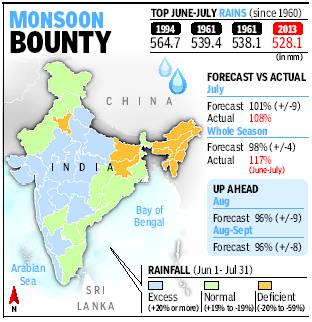Weather forecasts: India
This is a collection of articles archived for the excellence of their content. |
Contents |
Discrepancies
IMD’s monsoon prediction vs. Skymet’s
The India Meteorological Department had forecast a normal monsoon in 2018, pegging the countrywide rainfall at 97% of the long period average. The season ended on Sunday at a rain deficit of 9.4%, making the national weather agency’s forecast off by more than the 4% margin of error.
While IMD’s monsoon forecasts have in recent years been getting more accurate, this year the department has not just been more than 6% off target, it’s categorisation of “normal” seasonal rainfall too proved inaccurate. The monsoon ended in the “below normal” zone, close to the deficient category (below 10%).
“It was the high monsoon shortfall in September that led to the inaccuracy. We were expecting 90-91% rainfall in September after taking into consideration an evolving El Nino. But high convection activity in northwest Pacific during the month drew moisture away from our region,” said D Sivananda Pai, IMD’s lead monsoon forecaster.
In contrast, private forecaster Skymet, which had initially predicted 100% monsoon rainfall this year, made a course correction midway into the season.
In an update released on August 1, Skymet downgraded the monsoon to “below normal” at 92% of the long period average — a forecast that came close to the actual figure of about 90.6%.
Methods of forecast
2017/ a change to dynamic model
Jacob Koshy, Supercomputer to forecast monsoon with dynamical model, July 27, 2016: The Hindu
A dynamical monsoon model works by simulating the weather on powerful computers and extrapolating it over particular timeframes, which will be used by the IMD from 2017.
Though this method is normally effective in forecasting weather over a few days, using it to forecast the annual monsoon over 3 or 4 months has proved difficult.
While such models have been used for research purposes for long, the India Meteorological Department (IMD) has never integrated them into its operational forecast.
Differences between the traditional and dynamic model :
Traditional approach:
• An ensemble model, a statistical technique that uses an average of 6 meteorological values correlated to the monsoon such as sea surface temperatures in the Pacific, and North Atlantic sea level pressure. These values are derived from century-old meteorological data linked to the historical performance of the monsoon.
• Has failed to predict monsoon failures, in 2002 and 2004, leading to calls by meteorologists for a new, modern system.
Dynamic model:
• Called the Coupled Forecast System version 2.
• Has far achieved only 60% accuracy in forecasting the monsoon.
• A confidence boost came when the dynamical model's forecast along with the traditional one, its plans to give prominence to the dynamical model signals a new approach.
• This is a precursor to giving monsoon predictions over India’s 36 sub-divisions rather than only four broad geographic regions that encompass them. A dynamical approach can also be more easily tuned to account for rapidly changing global weather conditions.
Monsoon, actual and forecast
1960-2013
See graphic, ' Monsoon, actual and forecast, 1960-2013 '
2000-15

See graphic, ' Monsoon, actual and forecast, 2000-15 '
2003-2015

See graphic, 'Weather forecasts: India, 2003-2015'
2009-16

See graphic, 'Weather forecasts: India, 2003-2015'
